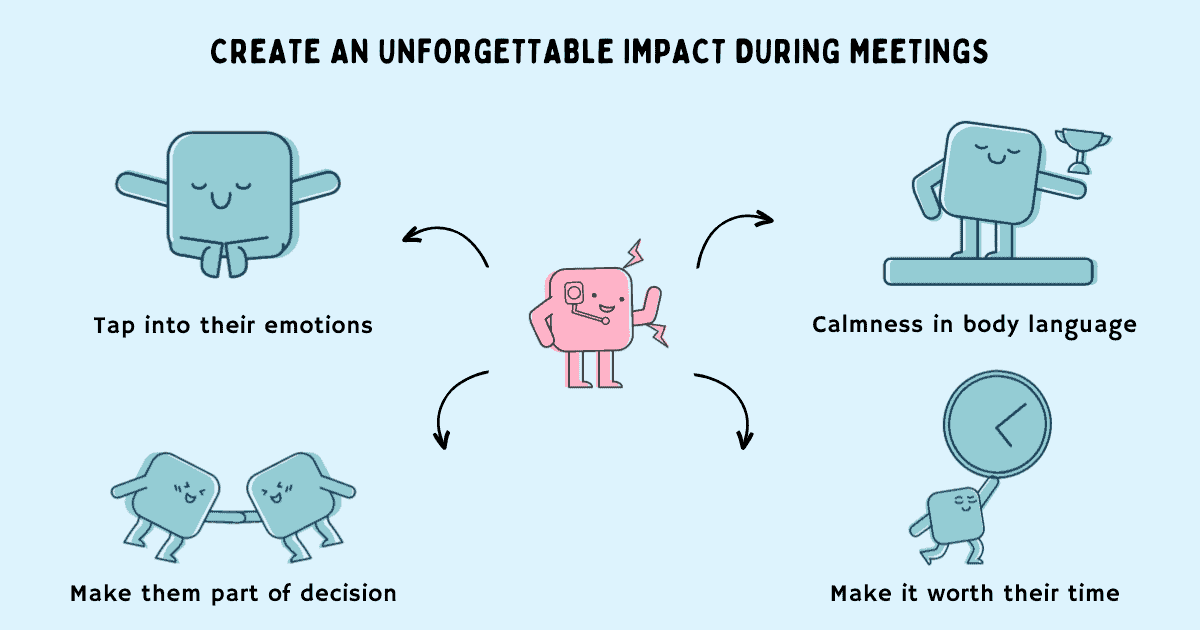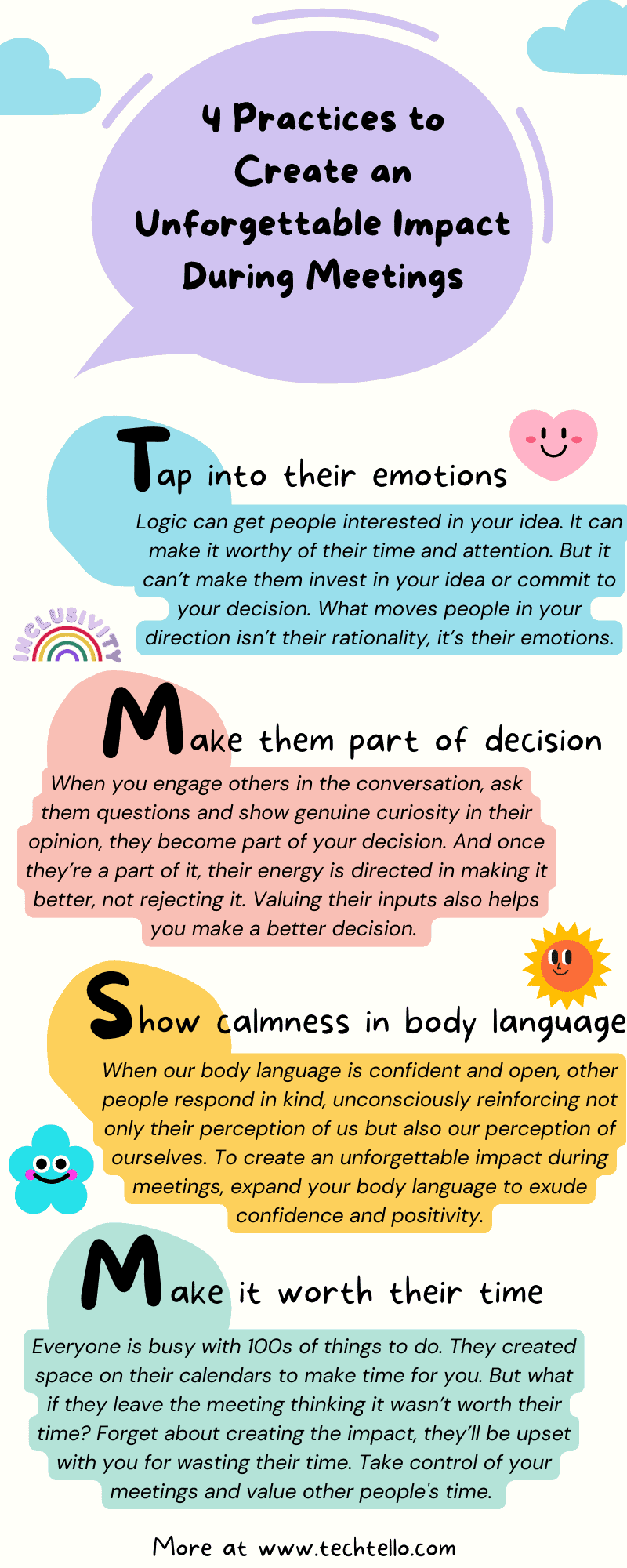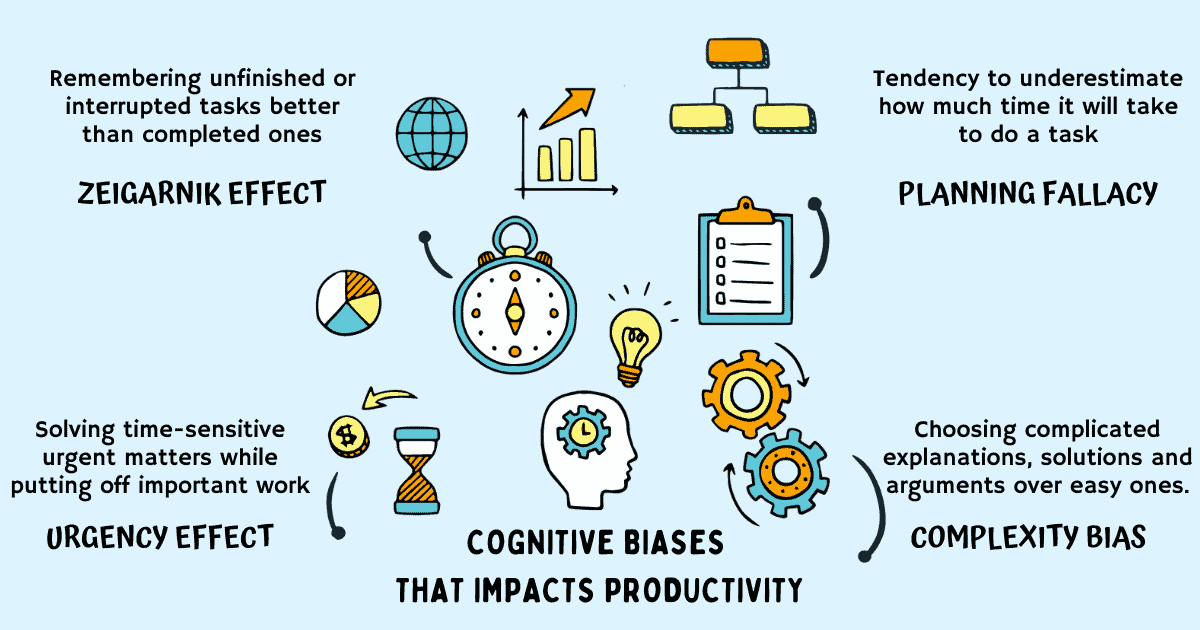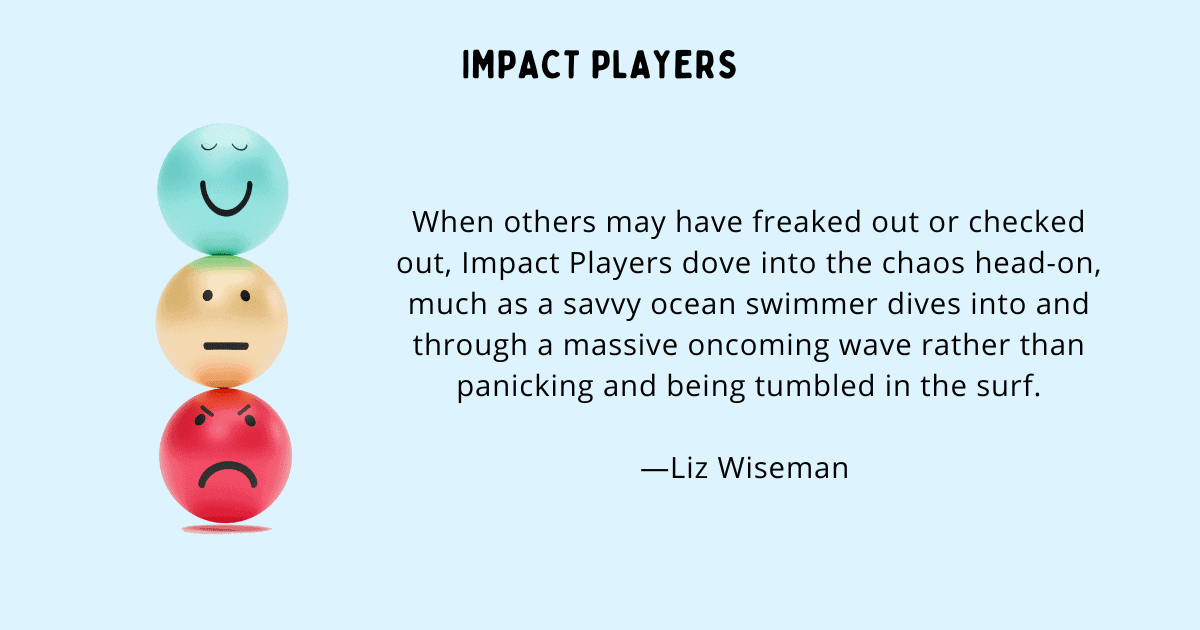How to Create an Unforgettable Impact During Meetings

Meetings were always extremely stressful for me especially when I was dealing with a difficult decision and needed other people’s buy-in.
I worried about being unprepared, uncharming and not knowing what to say when someone asked me a question. So I over prepared, tried to appear likable and didn’t give an opportunity to others to ask questions.
But instead of acceptance, I got resistance. The harder I tried to win others, the more they rejected my ideas and pushed back on my decisions.
My intentions weren’t wrong. I just wanted others to believe me, see my ideas through and vouch for them. But none of my efforts left a good impression. I was trying to make my meetings impactful by following a faulty process. I was focusing on myself instead of focusing on the process.
Once I started paying attention to my process, I discovered four key areas that made my meetings less stressful and more impactful. Others not only invested in my ideas, I got a ton of positive feedback on the effectiveness of my meetings.
These practices are simple yet powerful. They don’t demand a lot of work or preparation, only presence. Paying attention to the participants in the meeting, trying to assess their needs and shifting the focus of the meeting from me to them made my meetings an instant hit.
Try these 4 practices to create an unforgettable impact during impacts:
Tap into their emotions
I thought logic would be enough when it comes to winning people over and getting their buy-in. I was absolutely wrong.
Logic can get people interested in your idea. It can make it worthy of their time and attention. But it can’t make them invest in your idea or commit to your decision. What moves people in your direction isn’t their rationality, it’s their emotions.
Your idea truly connects with people when it appeals to their emotions. The feeling comes first and then it triggers the right action.
James Clear says in Atomic Habits “Emotions drive behavior—Every decision is an emotional decision at some level. Whatever your logical reasons are for taking action, you only feel compelled to act on them because of emotion.”
Providing context, stating facts, and sharing data to back up your point is important. It makes your idea credible and is bound to get their attention. But it isn’t enough to persuade them to move in your direction. Once you have their intellectual attention, you need to tap into their emotions.
An excellent strategy to engage their emotions is through storytelling. McKee, author of the book Story says “Stories fulfill a profound human need to grasp the patterns of living—not merely as an intellectual exercise, but within a very personal, emotional experience.”
With storytelling, you don’t need to rely on reason alone. You can connect, inspire and make it unforgettable by turning your idea into an emotional experience. Good storytelling requires a little bit of creativity to make it memorable, but it’s a skill that can be mastered with practice and experience.
Make them part of the decision
My meetings were earlier filled with one voice—mine—as I did most of the talking. It was an avoidance tactic. I feared that pausing would give others an opportunity to ask questions.
What if I don’t know the answer to the question?
What if they didn’t like my response?
Refusing to engage with others by focusing only on what I had to say without considering their viewpoint made them lose interest in my idea. Expecting them to commit without contribution clearly didn’t work. I got less nods and more disapprovals.
Kerry Patterson says in Crucial Conversations “People who are skilled at dialogue do their best to make it safe for everyone to add their meaning to the shared pool—even ideas that at first glance appear controversial, wrong, or at odds with their own beliefs. Now, obviously they don’t agree with every idea; they simply do their best to ensure that all ideas find their way into the open.”
I was missing this most crucial element of a good conversation—engagement. When you engage others in the conversation, ask them questions and show genuine curiosity in their opinion, they become part of your decision. And once they’re a part of it, their energy is directed in making it better, not rejecting it. Valuing their inputs also helps you make a better decision.
Maya Angelou famously said “People will forget what you said, people will forget what you did, but people will never forget how you made them feel.” Create a lasting impact by making your meetings more inclusive and leaving meeting participants feeling valued and respected.
Meeting Minutes Template
Keep track of key decisions, action items and other takeaways from the meeting with this worksheet.
Show calmness in your body language
I spent so much time on the verbal content of my meeting that I failed to pay any attention to my body language. While I was trying to win people over, my body language was screaming with doubt and lack of confidence.
It was hard for others to believe me when what I said verbally did not match what I communicated in my body language. Sending confusing messages to people led to cognitive dissonance—that conflicting mental state where contradictory information created anxiety and feelings of discomfort which impacted their decision making ability.
Body language expert Amy Cuddy says in her book Presence “When our body language is confident and open, other people respond in kind, unconsciously reinforcing not only their perception of us but also our perception of ourselves.”
To create an unforgettable impact during meetings, expand your body language to exude confidence and positivity:
- Reflect calmness in your body language, not aggression or frustration.
- Make eye contact more often.
- Speak slowly. Don’t rush or be afraid to pause.
To get into the right body language during meetings, follow Amy’s advice. She suggests “Preparation is obviously important, but at some point, you must stop preparing content and start preparing mind-set. You have to shift from what you’ll say to how you’ll say it.”
Practice your movements and gestures so that interest and enthusiasm that shows up in your words matches the non verbal signals that your body is sending.
Make it worth their time
Everyone is busy with 100s of things to do. They created space on their calendars to make time for you. But what if they leave the meeting thinking it wasn’t worth their time?
Forget about creating the impact, they’ll be upset with you for wasting their time.
I made exactly this mistake. I took ownership of the meeting but failed to take responsibility for its experience.
I was casual about starting the meeting on time.
I didn’t clearly state the agenda or set expectations on the expected outcome.
I let others sidetrack or waste time on topics that were not in the scope of the discussion.
I ended the meeting without summarizing the decision, action items or the next steps.
My ideas weren’t received well. I didn’t get their approval and acceptance. Valuing other people’s time was one of the greatest lessons of my career. It made me more effective in the way I approached others and made decisions. It also led to better relationships and more powerful conversations.
My meetings were super impactful once I factored in the value they will bring to others by asking myself how I can make them worth their time.
To leave a great impression in meetings and create a lasting impact, shift your focus from self to others—tap into their emotions, make them part of your decision, tune your body language to align with your words and make your meeting worth their time.
Summary
- Meetings can be extremely stressful unless you know how to run them well.
- Sharing your ideas and making others lean your way is not easy. The biggest mistake we all make when trying to make our meetings impactful is to place extreme focus on ourselves and the content of the meeting without paying much attention to the process.
- Giving context and clarity, sharing data to back up our point gets others attention. It does not get their approval. To get their buy-in, use the power of storytelling to tap into their emotion.
- When others aren’t given an opportunity to contribute, they find it hard to commit. They’re willing to invest only once you make them part of the decision.
- Conflicting messages through verbal and non verbal communication (hand movements, gestures etc) makes it hard for others to trust you and support your agenda. Aligning the two and calmly communicating your message is bound to make your meetings impactful.
- Taking other people’s time for granted in a meeting creates a terrible experience. If you want to leave a lasting impact, take control of your meetings and make it worth their time.






























